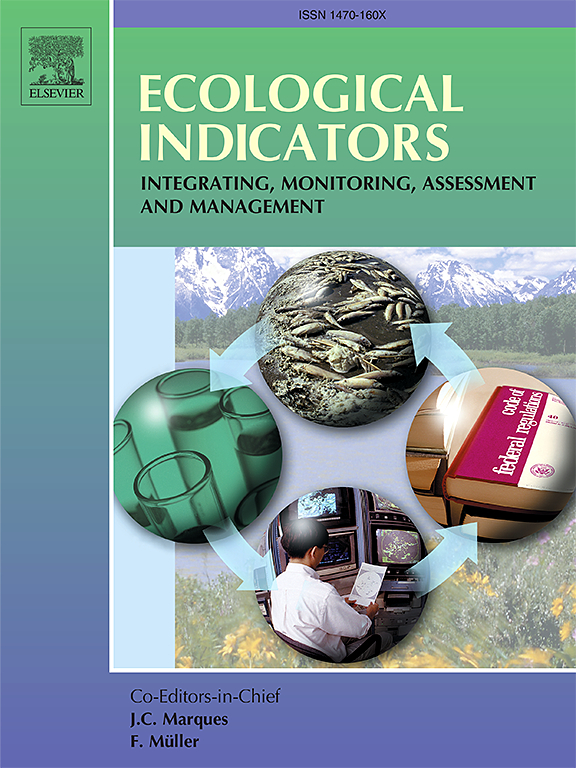Connectivity between MPAs assessed by the temporal Lagrangian flow networks: A case study in a semi-enclosed sea
IF 7
2区 环境科学与生态学
Q1 ENVIRONMENTAL SCIENCES
引用次数: 0
Abstract
The connectivity between Marine Protected Areas (MPA), defined as the migration and exchange of materials such as individuals or organisms, is critical for species dispersal and ecosystem recovery. In this study, the complex network framework is introduced to measure the connectivity between 22 MPAs in the Bohai Sea. A time-varying Lagrangian flow network is constructed based on particle transport. Subsequently, Dijkstra’s algorithm is utilized to identify the most probable paths (MPP) within the MPAs. The results indicate that the overall connectivity among the MPAs in the Bohai Sea is weak, with specific areas forming tightly connected clusters. The connection time between MPAs ranges from 10 to 70 weeks, and only 9 % of MPAs achieve connection within three months, which exceeds the survival time of most species’ larval stages. Louvain network clustering analysis reveals four main MPA communities in the Bohai Sea: Liaodong Bay, Qinhuangdao Coast, Bohai Bay, and Laizhou Bay, which are closely connected internally but sparsely connected to other communities. Four MPAs in Daling River estuary, Beidaihe marine park, Yellow River estuary, and Laizhou Bay shoal national marine ecological special protected area are identified as hub nodes, connecting the most of other MPAs in the community, acting as critical nodes for maintaining connectivity within the protected areas. Overall, the connectivity between MPAs is largely influenced by the Lagrangian residual currents in the Bohai Sea, with the central anticyclonic eddy and the western coastal current playing significant roles in facilitating MPA connectivity. This study offers a transferable framework for assessing MPA connectivity and provides guidance for optimizing MPA network design.
由时间拉格朗日流网络评估的海洋保护区之间的连通性:一个半封闭海的案例研究
海洋保护区(MPA)之间的连通性,被定义为个体或生物等物质的迁移和交换,对物种扩散和生态系统恢复至关重要。本文采用复杂网络框架对渤海22个海洋保护区之间的连通性进行了测量。建立了基于粒子输运的时变拉格朗日流网络。随后,利用Dijkstra算法识别MPAs内的最可能路径(MPP)。结果表明:渤海海洋保护区之间的整体连通性较弱,特定区域形成了紧密连接的集群;海洋保护区之间的连接时间为10 ~ 70周,只有9%的海洋保护区在3个月内实现连接,这超过了大多数物种幼虫期的生存时间。Louvain网络聚类分析显示,辽东湾、秦皇岛沿岸、渤海湾和莱州湾4个主要的MPA群落内部联系紧密,但与其他群落之间的联系较少。将大陵江口、北戴河海洋公园、黄河口和莱州湾浅滩国家海洋生态特别保护区4个海洋保护区确定为枢纽节点,连接群落内大部分海洋保护区,是维持保护区内连通性的关键节点。总体而言,渤海海洋保护区之间的连通性在很大程度上受到拉格朗日残余流的影响,其中中央反气旋涡和西部沿海流对海洋保护区的连通性起着重要作用。本研究为海洋保护区连通性评估提供了一个可转移的框架,并为海洋保护区网络优化设计提供了指导。
本文章由计算机程序翻译,如有差异,请以英文原文为准。
求助全文
约1分钟内获得全文
求助全文
来源期刊

Ecological Indicators
环境科学-环境科学
CiteScore
11.80
自引率
8.70%
发文量
1163
审稿时长
78 days
期刊介绍:
The ultimate aim of Ecological Indicators is to integrate the monitoring and assessment of ecological and environmental indicators with management practices. The journal provides a forum for the discussion of the applied scientific development and review of traditional indicator approaches as well as for theoretical, modelling and quantitative applications such as index development. Research into the following areas will be published.
• All aspects of ecological and environmental indicators and indices.
• New indicators, and new approaches and methods for indicator development, testing and use.
• Development and modelling of indices, e.g. application of indicator suites across multiple scales and resources.
• Analysis and research of resource, system- and scale-specific indicators.
• Methods for integration of social and other valuation metrics for the production of scientifically rigorous and politically-relevant assessments using indicator-based monitoring and assessment programs.
• How research indicators can be transformed into direct application for management purposes.
• Broader assessment objectives and methods, e.g. biodiversity, biological integrity, and sustainability, through the use of indicators.
• Resource-specific indicators such as landscape, agroecosystems, forests, wetlands, etc.
 求助内容:
求助内容: 应助结果提醒方式:
应助结果提醒方式:


